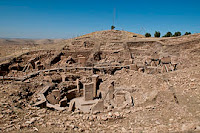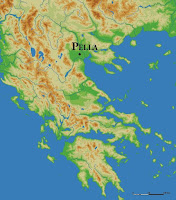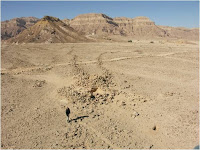Archaeological Mysteries in Biblical Lands
There are many unknowns in archaeology. While these scientists have the ability to reconstruct many elements of ancient life and cultures, it is not an exact science and some definitions still elude them. Biblical lands and the people who inhabited them are no exception to these mysteries. There are a great many unknowns from the lands of the Bible and the areas surrounding them. This is due in large part to the vast amount of time the land has been inhabited and by the number of different cultures that have lived in, shaped, and been a part of the landscape. In this post we will examine just four of these mysteries. The first is from the region of southern Turkey and could be the sight of the earliest organized religious center known to man. Then we will move on to a massive underwater structure in the Sea of Galilee, a mysterious tomb in Pella and strange outlines in the deserts of Jordan. All of these defy an easy or scientific explanation. While not always elaborate in nature, they are outside the norm either in time, location or construction.
We will examine what these structures could mean, how they were used, and there ultimate meaning. These will all be educated guesses, as no one can provide conclusive evidence for any given theory. These are just a sampling of the archaeological mysteries of the biblical lands.
Gobekli Tepe
Just north of Syria, in Southern Turkey, archaeologist have been excavating a site which they believe represents the earliest religious center ever discovered. The excavations began in 1994 and have thus far uncovered at least four monumental stone circles. These circles somewhat resemble the well-known ‘Stonehenge’ but pre-date that monument by as much as 7,000 years. Archaeologist who are unearthing these huge stones place the original construction of the monuments at somewhere between 8,000 and 10,000 B.C. or approximately 7,500 years before the advent of agriculture.
The advent of Agriculture is of vital importance in regards to Gobekli Tepe for a very simple reason. According to the physical evidence, when man first made his appearance on earth he did so as a hunter/gatherer. Early man is thought to have roamed an area or region searching for food in the form of eatable vegetation or wild game. At this stage man is not thought to have had a central home, or den. He would instead find shelter on a daily basis. If food was plentiful in a certain area he may remain there for a more extended period, but when the food supply was depleted, he would move on to another area. A migratory species so to speak, following the food supply.
At some point, approximately 4,500 years ago (2,500 B.C.), man began to change his habits. Rather than roaming to find food, man began to plant crops. As agriculture developed man began to settle into certain areas or regions in order to care for and protect these crops which were rapidly becoming his primary food source. It was at this stage that the first villages or settlements began to emerge. Life in a community is believed to have brought on the need for religion. This need was twofold. The first need religion helped to satisfy was to control how people worked and cohabitated with one another. How man treated one another was apparently believed to be important to the divine and a set of morals were established. Not only pleasing to the divine being, it made the village safer, more pleasant, and more productive. The second use of religion was to please the divine in order to insure a good and bountiful crop. This theory was almost universally accepted by most modern day scholars. This theory is now being reexamined and may need to be completely discarded.
While the stone monuments at Gobekli Tepe pre-date
any form of agriculture, there is another interesting fact concerning these
excavations. Thus far no residential areas or structures have been discovered associated
with these monuments. It appears these monuments were not a part of any village
and were used by people who had not yet begun to function as a community. It is
also clear these structures were spiritual or religious centers and appear to
disprove the theory man did not develop religion until after they began to
gather into communities and men were, it seems, concerned with pleasing a divine being, God, while they were still wandering nomads.
Tests have revealed the possibility of as many as a dozen more circles remain buried at the site. It has also surprised many that while the stones are ancient, placed more than 6,000 years before the Egyptians built the first pyramid, they contain amazing detail and show great craftsmanship was used in their construction. Carvings on the stones depict birds, snakes, lions, bulls, foxes, and many other types of animals. They also show arms and hands, all of which show great detail. The stone circles are arranged with as many as twelve stones in circles from 30 to over 60 feet in diameter. Some of the massive stones are as much as 18 feet tall and can weight over 40 tons. Just how the stones were quarried, moved and erected remains a mystery as well. In 10,000 B.C. even simply hand tools were rare, and it must be remembered this was not the work of a village or organized community, but a group of nomad hunter/gatherers apparently worked together on a massive building project. Just the amount of planning and coordination of resources needed would have been enormous/
The monuments at Gobekli Tepe are
thought to have been in use by their builders/worshippers for over 1,500 years.
The sites were then filled with sand and the people seem to have simply walked
away, never to return. Filling in this 20 acre site would have taken a
considerable amount of time, effort, and resources to accomplish. It is unclear
why the site was abandoned, why it was deemed necessary to bury the site, or
even who these builders and worshippers were. Much more work remains to be done
as only 10 percent of the site has been excavated, but for now at least, the structures at Gobekli Tepe remain a mystery.
Underwater
Structure in Sea of Galilee
The discovery of an ancient submerged structure in the Sea of Galilee was announced in late 2013. The age, origin and use of the structure remains shrouded in mystery. Scientist discovered the structure using sonar but no true excavations have been conducted. The nature of the structure and its depth make easy examination difficult, but efforts are underway to raise funding for further study. There are several questions concerning this structure as it relates to Biblical Archaeology. First, how old is the structure? who built it? what was it used for and does it support or conflict any information found in the Bible? Answers to some of these questions are problematic at best.
Currently scientist have no idea who constructed the underwater structure that measures 50 meters (164 feet) across , nor do they agree on how the structure was made. One theory is the structure was made while the area was dry land and the lake later rose to cover the structure and surrounding area. This would have made the construction of the round stone mound much easier, but the theory is not without its detractors.
Others theorize the structure is actually intended to attract and support aquatic life. The Sea of Galilee has a long history of an economy based on fishing which is referenced to several times in the New Testament. Other stone fish hatcheries have been discovered in the Sea but nothing of this size. Most are no more than four meters across and are very close to shore. (A fish hatchery can be nothing more than a pile or mound of rocks that provides safety for small fish and allows them to breed and re-populate the lake more easily.) If indeed the structure was intended as a fish sanctuary/hatchery it was most likely constructed while the lake was at its current level. If this second theory is correct, and it certainly seems the most plausible theory, it drastically changes the difficulty of construction. It would have required a great deal of effort and coordination to haul the vast numbers of stones needed out into the lake. It would also be difficult to form the nearly perfect circle of stones by simply dumping a boat full or rocks into the lake one at a time.
Who
is Buried in the Pella Tomb?
In Pella a Byzantine era church was excavated and in the north apse was discovered a stone lined tomb. This is
significant for a number of reasons. In a Byzantine church the north apse was
almost exclusively reserved for the tomb of a martyr. Secondly, the tomb was
dated to the late first century, perhaps around 80 A.D. This places the tomb in
the proper time frame for the Christians who Eusebius said fled to Pella. It is
also extremely interesting that it appears the Byzantine church was built
around the tomb. The layout of the church seems to have been designed as to
accommodate and thus not disturb the tomb below. This seems to signify the
builders of the church felt the person buried in the tomb was not only a
martyr, but someone of significant importance to warrant a church being
constructed around the tomb. But just who was buried in the tomb remains a
mystery.
[Byzantine Era - Begun in 330 A.D. and lasted until approximately 1453 A.D. It was basically the continuation of the Eastern Roman Empire. Its capital was Constantinople and it was primarily Christian. The Byzantine empire had Greek origins and is credited with great works of learning and art.]
While the tomb itself was dated to the late first century A.D. the skeletal remains found inside were dated far differently. Carbon dating of the remains gave a date in the sixth century, some five hundred years too late for the remains to belong to a first century Christian. This was confusing to researchers who had to question how someone who died in the sixth century ended up in a tomb dated to the first century? While the remains were tested, the issue of the age of the remains is till a point of debate. Dr. Bourke points out the bones were severely damaged, as if they had been subjected to a harsh chemical. It is theorized there was a natural chemical reaction within the tomb which caused this damage and Dr. Bourke believes this may have rendered the original carbon dating results invalid. Attempts are currently underway to have the remains re-tested using more modern and hopefully more reliable dating methods. If the original dating is found to be in error, it is felt the age of the remains will likely match the age of the tomb, placing them around 80 A.D.
[Early church historian Eusebius tells of how the followers of Jesus fled the Romans in 70 A.D. - According to Eusebius one of the areas these early Christians fled to was Pella.]
Very little is known about the
tomb’s occupant. It is known the remains were those of a man who was
considerably taller than the average man in those days. He was not only a tall
man but apparently a very large man as well. It is also believed he was well
advanced in years at the time of his death. If in fact he was buried in the
tomb in 80 A.D. and was between 70 and 85 years of age, he would have been in
his mid to late thirties during the time when Jesus was alive. Was this man an
important figure in the early church? Did he know and follow Jesus during His lifetime?
Was he martyred for his faith in Christ? These are questions we simply do not
have the answers to. We do know that the tomb was felt to be important enough
that a church was designed and built around it. The tomb was also located at a
position within the church normally reserved for a martyr. While we may never
know the identity of the occupant of the Pella tomb, one thing is very clear.
At the time the church was planned and constructed this person was believed to
have been a very significant figure to the people of Pella and most probably a
significant figure in the early Christian church. Excavations at Pella continue
so we can only hope additional clues as to the identity of the occupant of the
tomb may be forthcoming .
Kites
of Israel, Jordan and Egypt
Early in the 20th century archaeologist discovered a series of low stone walls located in the deserts of Jordan, Israel and Egypt. These walls are only visible from the air and were nicknamed ‘kites’. The
walls date back to at least 300 B.C. and have puzzled experts for decades. Who built them and why remains a mystery although recently some scholars have announced they may have found the purpose of the kites.It is now believed the walls were
meant to funnel wild animals into a pit where they could be killed in a much
more efficient manner. Rather than chase the animals across the desert they
were allowed to come or be driven to the hunters. Scholars point out if this
theory is correct it would mean ancient man knew a great deal more about animal
behavior than previously known. The kites, while simple in design, were not
simple to build. Some of the kites stretched as far as forty miles (64
kilometers) across the desert. Simply walking forty miles into the desert is no
simple task, but add to this the fact they were transporting or gathering
stones for construction complicates the process considerably.
The theory the kites are intended to entrap animals seems to fit the evidence, but it remains only a theory of a fascinating mystery which has perplexed the experts for decades.
Did you enjoy this article? Follow this Blog to get new posts sent to you.



Comments